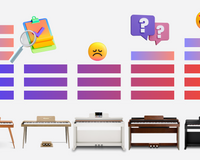Learning to play the piano is never easy. Buying a piano, like buying anything you are not familiar with, can be complicated too. With Donner Music, you can find one-stop solutions to learn and buy the ideal piano for you.

What Kinds of Pianos Are Best for Beginners?
You are not learning the piano until you get your hands on it. That said, you still need to know some essential things. The first thing is to know the difference between acoustic pianos and digital pianos.
Acoustic pianos are what we mostly see in theaters and concerts. They generate sounds by transforming the force on keys with a mechanical hammer structure. Usually, acoustic pianos tend to be large and heavy. Its tuning and maintenance require professional personnel to operate on-site.
On the contrary, digital pianos generate sounds through electronic signals. Without the mechanical acoustic structure, a digital piano tends to be very compact. Some variants like keyboard pianos can even be quite portable. As its tuning can be done with simple digital adjustment.
That's why we recommend beginners start learning the piano with digital pianos. We've written an in-depth article on how to make sure a digital piano is best for learning to play the piano.
How to Choose a Digital Piano for Beginners
Once we've decided to start learning the piano with a digital piano, the next question is how to choose a digital piano. Here are five things you need to know before buying a digital piano for beginners.
First, make clear the types of digital pianos. There are upright digital pianos and portable digital pianos. The latter includes keyboards.
Upright pianos come in a nice enclosure that resembles an acoustic piano. Compared with keyboards, they are more classic-looking and therefore more decorative for homes. Popular upright pianos include DDP-100 and DEP-10.

The Donner DDP-100 is an 88-key upright digital piano with fully-weighted keys to simulate the genuine hammer touch. With multiple MIDI/USB/Audio jacks and Bluetooth connectivity, it's suitable for both beginners and pros.
Donner DEP-10 Beginner Digital Piano

Featuring 128 note polyphony and 8 premium sound libraries, the DEP-10 with half-weighted hammer keys gives a more sensitive touch response to your playing.
Once you know the differences between upright and portable digital pianos, you are good to proceed to choose the right piano for you. In How to Choose a Digital Piano for Beginners, Donner experts give detailed guidance on how to select a digital piano based on your budget, environment, and expectation.
Key Features of Digital Pianos to Consider
Sound Quality
The sound quality of digital pianos depends heavily on electronic components. Always look for digital pianos with the best output section.
A shortcut is to look for pianos with larger storage and memory, as better sound profiles usually need a larger capacity to store and playback.
Key Response and Sensitivity
The weight, feeling, and response of the keyboard are important factors in any keyboard purchase. While acoustic pianos can give your fingers feedback physically, digital pianos usually simulate that feedback with weighted keys. The keys on digital pianos can be weighted, semi-weighted, or fully weighted.
Weighted ones feel closest to mechanic pianos. Fully-weighted keys are an upgrade to weighted keys as they incorporate linear weighting. This means that lower notes feel heavier than they would on an acoustic piano.
The sensitivity of the keys is also an important factor. Velocity sensors can capture how fast and hard you hit the keys and play the corresponding sounds. High-end digital pianos capture the most subtle changes in your strike and then determine the timbre and volume of the sounds.
Number of Tones
It is great to have all kinds of instruments' sounds in one: acoustic pianos, drums, string instruments, as you name it.
However, don't put quantity over quality. It may seem intriguing at first, but always look for a digital piano with the best piano sound within your price range.
Polyphony
Polyphony is the number of notes a piano can play at the same time. Normal models provide 32-note and 64-note polyphony. You can begin with a piano that has 32 notes. The greater the polyphony, the better. You can go with 128 notes and even higher for more advanced playing.
Amplification and Expansion
If you play the piano mostly at home, having an amplifier that sounds good is important. If you are looking to play shows, then make sure that your piano has the right outputs to plug into a public address (PA) system.
Backtracking and Tools
Manufacturers often incorporate functions that help beginners practice straight out of the box, such as the ability to play back certain rhythmic patterns at various speeds.
Practicing aside a metronome is always recommended for beginners to develop a sense of rhythm.
What Are Other Kinds of Digital Pianos?
If upright digital pianos and keyboards have been too familiar to you, you can look further into special kinds of digital pianos, such as MIDI keyboards that are small, full of knubs, and produce unique sound effects.

You can also learn something about synthesizers, or simply "synths". They are used by music creators but are also good tools for amateurs to learn music basics and production knowledge. Here is a professional musician's review of Donner's most popular B1 bass analog synthesizer, by musician David Hilowitz.
In addition to its classic design, the B1 synth is very versatile in regard to input and output options. Read the article to see why David spoke so highly of its performance-price ratio and design.
Things to Know Before Learning the Digital Piano
If you have decided to start learning with a digital piano, especially with an electric keyboard, here is a great article on how to start learning digital pianos. It lists the top things you need to consider and prepare, such as the fundamental setup, the sitting position that won't hurt, and the right places to seek free tutorials.





































